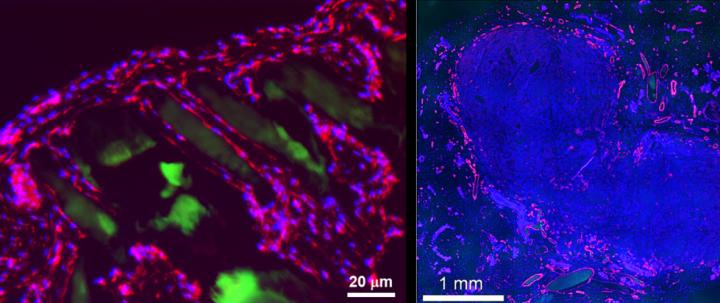![Prellis structure transplanted alone is surrounded by single cell walled capillaries within two weeks of transplantation into immunocompetent mouse (left). Human tumor cells transplanted in Prellis structures grow rapidly, are highly vascularized and demonstrate minimal hypoxia (right) (red = CD31, blue = DAPI, green = printed structure) [Image: Prellis Biologics]](https://fabbaloo.com/wp-content/uploads/2020/05/Prellis_img_5eb0931e8cb5d.jpg)
San Francisco-based biotechnology company Prellis Biologics has raised $8.7M in a Series A funding round.
The round was led by Khosla Ventures, which has previously participated in funding for such 3D printing ventures as Digital Alloys. It also included participation from True Ventures and Indio Bio (SOSV), which were original seed round investors. Prellis Biologics has now seen a total investment of $10.5M.
Holographic Bioprinting
Prellis’ platform centers around its holographic bioprinter, the Holograph X, created with CELLINK.
The 3D printer is being put to use in creating 3D tissue and organs to be used in research and, eventually, transplantation.
Prellis has recently achieved “major tissue engineering milestones” in fulfilling this mission, presumably building the confidence of both new and returning investors.
Bioprinting human tissue is of course no simple proposition. It remains something of a holy grail in medicine today, and R&D is continuing around the world to eventually be able to create lab-made functional tissue and organs.
“Regenerative medicine has made enormous leaps in recent decades. However, to create complete organs, we need to build higher order structures like the vascular system,” said Dr. Alex Morgan, Principal at Khosla Ventures. “Prellis’ optical technology provides the scaffolding necessary to engineer these larger masses of tissues. With our investment in Prellis, we’re supporting an initiative that will ultimately produce a functioning lobe of the lung, or even a kidney, to be used in addressing an enormous unmet global need.”
Human bodies are remarkable systems, with an impressive ability to regenerate following damage. Disease and injury, though, make the need for replacement parts, as it were, ever present and to date the best solution has been through organ donation — largely from compatible cadavers. The ideal here is to be able to lab-grow compatible organs, like skin and livers, that would not only shorten transplant lists but would cut the risk of rejection. Today, any transplant recipient must spend the rest of their life taking anti-rejection therapies —- unnecessary, though, when their new kidney was made from their own cells.
It is here that Prellis has been focused. The company says:
“We revolutionized the 3D Bioprinting industry by developing a holographic bioprinter that solves the final roadblock in building lab-grown human tissues: rapid production of oxygen-supplying blood vessels and biocompatible tissue scaffolds that match those found in human tissues. They can be used to culture any cell type, therefore we are working with over 30 academic and industry groups, supporting the development of 3D tissues for transplantation and therapeutics screening in liver, kidney, and neuronal diseases, as well as diabetes, muscular dystrophy, and cancer.”
Milestones
The milestones mentioned are three-fold, demonstrating Prellis’ tangible advances in bioprinting:
-
Success in animal transplants
-
Pharmaceutical and academic tissue delivery
-
Progress in microfluidic flow
The company’s Vascular Tissue Blanks, its 3D tissue scaffolds, were transplanted at Stanford University. Transplanting 200,000 cells — rather than the more standard two million-plus cells — showed success in tumor engraftment and vascularization. The scaffolds saw 10-micron capillaries grow spontaneously, growing within eight weeks to become “large, branched vasculature up to 50 microns…indicating the animal’s vasculature system had adopted the scaffolding and incorporated it into its own circulatory system.”
“A breakthrough like this opens the door to studying rare human tumors and complex human tumor immune system reactions. It has the potential to significantly reduce overall animal use and speed up drug discovery efforts,” said Dr. Melanie Matheu, Prellis Biologics’ Co-Founder and CEO.
In the pharmaceutical and academic markets, the Vascular Tissue Blanks are now subject to experimentation with more than 30 labs. Prellis’ setup has been found to streamline research, including up to 90% time reduction for drug screening in 3D organoids versus other 3D cell culture technologies. 3D organoid drug screening results obtained with use of these pre-made tissue scaffolds can be turned around as quickly as two days.
In terms of microfluidic flow, Prellis has progressed in in vitro results with complex vascular channels. They note:
“Prellis’ R&D team is currently testing 10-20 micron biomaterial interface for cell-cell interactions and nutrient exchange – the first steps in ensuring a functional filtration and gas exchange system, critical building blocks for organ systems such as the lung and kidney.”
Next Steps
The investment round will surely aid Prellis on its next steps forward in bioprinting.
In the near term, the company is aiming to begin its first large animal studies. These are expected to start in 2019, as Prellis will test engineered arterial replacements, working with 3-4mm diameter tissues. These, the company’s CEO notes, are “a natural stepping-stone to production of larger solid organs.”
The ultimate goal is, of course, human organ transplantation.
“The holy grail of human tissue engineering is the ability to build complex tissues with working vascular systems,” said Dr. Matheu. “The future of regenerative medicine revolves around harnessing the power of our own cells as therapeutics and building the tissues to keep them alive. Khosla Ventures is the perfect investor to support our merging of deep tech and cutting-edge regenerative medicine. With this technology in hand, we can begin to ask questions about real 3D cell biology that have never been asked before.”











FELIXprinters has released a new bioprinter, the FELIX BIOprinter, which is quite a change for the long-time 3D printer manufacturer.